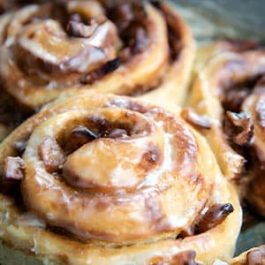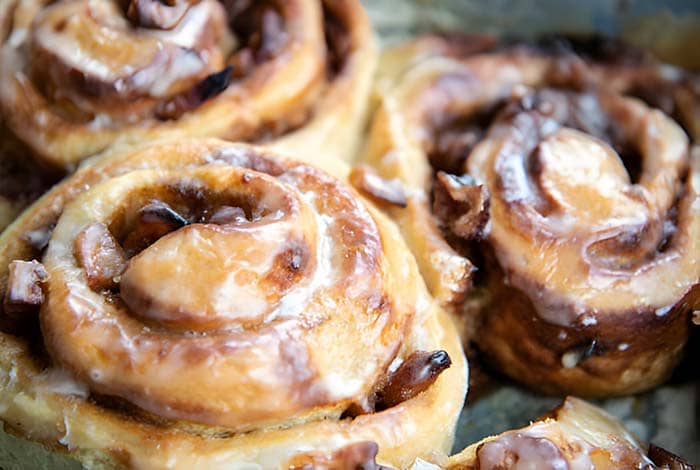Introduction to Cinnamon Rolls
Cinnamon rolls, a beloved pastry enjoyed worldwide, have a rich history that traces back to Europe. These sweet, swirled breads, known for their distinctive spiral of cinnamon-sugar filling, are thought to have originated in Sweden in the 1920s, where they are called “kanelbulle”. Unlike the heavily frosted American version, the Swedish cinnamon roll is typically less sweet and marked by its signature pearl sugar topping. The concept quickly spread across Europe and the Americas, adapting to local tastes and ingredients.
The universal appeal of cinnamon rolls lies in their comforting warmth, the irresistible combination of soft bread and sweet, spicy filling, and the enticing aroma that fills the kitchen during baking. They’ve become a symbol of cozy mornings, special occasions, and everything in between. Their versatility also plays a role in their popularity; whether served as a luxurious breakfast, a delightful dessert, or a comforting snack, cinnamon rolls have a special place in the hearts of many. This widespread adoration ensures their place in bakeries and kitchens around the world, continually inviting innovation and tradition in every bite.
The Making of Cinnamon Rolls
Ingredients for Cinnamon Rolls
Creating cinnamon rolls from scratch involves a blend of simple ingredients that come together to create something truly magical. The dough is the foundation, typically consisting of:
- Flour: The base of the dough, providing structure.
- Milk: Adds richness and tender texture.
- Sugar: For sweetness and to feed the yeast.
- Yeast: The leavening agent that makes the dough rise.
- Butter: Adds flavor and tenderizes the dough.
- Eggs: Enrich the dough for a softer texture.
- Salt: Balances the sweetness.
For the filling, you’ll need:
- Cinnamon: The star spice, offering warm, spicy notes.
- Brown Sugar: For a deep, caramel sweetness.
- Butter: Adds moisture and helps the sugar and cinnamon stick to the dough.
Step-by-Step Recipe
- Prepare the Dough: Warm the milk slightly, then mix with yeast and a pinch of sugar. Let it sit until frothy. In a large bowl, combine flour, sugar, and salt. Add the yeast mixture, melted butter, and eggs. Knead until smooth, then let rise until doubled in size.
- Make the Filling: Mix softened butter with brown sugar and cinnamon.
- Shape the Rolls: Roll out the dough into a rectangle. Spread the filling evenly, leaving a small margin at the edges. Roll the dough tightly from one long edge to the other. Cut into even pieces.
- Second Rise: Place the cut rolls in a baking dish, cover, and let rise until puffy.
- Bake: Bake in a preheated oven until golden brown. Optionally, top with icing or glaze after baking.
Baking Tips:
- Ensure your milk is warm, not hot, to avoid killing the yeast.
- Allow the dough to rise in a warm, draft-free area.
- For even baking, cut rolls to a uniform size.
Variations of Cinnamon Rolls
Cinnamon rolls are incredibly versatile, allowing for numerous variations to suit any preference:
- Fillings: Beyond the classic cinnamon and sugar, consider adding apple pie filling, chocolate chips, or nuts for texture.
- Toppings: While a simple glaze of powdered sugar and milk is traditional, cream cheese icing adds a rich decadence. A sprinkle of chopped nuts or a drizzle of caramel are also delicious options.
- Flavors: Incorporate orange zest into the dough or filling for a citrus twist, or cardamom for a Scandinavian variation.
Experimenting with these elements allows for endless creativity, making each batch of cinnamon rolls a new discovery.
Health Considerations
Cinnamon rolls, while undeniably delicious, are high in calories, sugars, and fats due to their ingredients like butter, sugar, and flour. A single large cinnamon roll can contain upwards of 300 to 400 calories, with significant amounts of fat and sugar. For individuals with dietary restrictions or allergies, it’s important to note that traditional recipes include gluten, dairy, and sometimes nuts. Health-conscious individuals can opt for substitutions, such as whole wheat flour, plant-based milk and butter, and natural sweeteners like maple syrup or honey, to improve the nutritional profile. Always consider portion sizes and enjoy these treats as part of a balanced diet.
How to Serve Cinnamon Rolls
Cinnamon rolls are best served warm to maximize their soft texture and aromatic spices. Heating them briefly in the microwave or oven can revive the gooeyness of the filling and make the icing melt slightly, enhancing their appeal. They pair wonderfully with a cup of coffee or tea for a comforting breakfast or a mid-afternoon treat. For an extra indulgent experience, consider adding a scoop of vanilla ice cream on top of a warm roll for a delightful dessert.
Storage Tips
To keep cinnamon rolls fresh, store them in an airtight container at room temperature for up to 2 days. For longer storage, refrigerate them for up to a week, ensuring they’re tightly covered to prevent drying out. Cinnamon rolls can also be frozen for up to 3 months. Wrap each roll individually in plastic wrap and place them in a freezer bag. Thaw overnight in the refrigerator or briefly in the microwave when ready to enjoy. Reheating in the oven can help restore their original texture.
FAQs
- How can I make my cinnamon rolls fluffier? To achieve fluffier cinnamon rolls, make sure your yeast is active, and the dough is properly kneaded and given enough time to rise. A warm, draft-free environment is crucial for the rising process. Additionally, using a higher protein content flour like bread flour can enhance the structure and fluffiness.
- What are some vegan alternatives for cinnamon rolls? Vegan cinnamon rolls are easy to make by substituting plant-based ingredients for traditional ones. Use almond or soy milk instead of dairy milk, vegan butter in place of regular butter, and flaxseed or chia seed mixtures as an egg replacement. There are also many commercial vegan cream cheeses available for frosting.
- How can I make gluten-free cinnamon rolls? Gluten-free cinnamon rolls require a gluten-free flour blend designed for baking. Look for a mix that includes xanthan gum, which helps replicate the texture of gluten. Keep in mind that gluten-free dough can be more fragile, so handle it gently when rolling and shaping the rolls.
Adapting recipes to meet dietary needs or preferences allows everyone to enjoy the comforting delight of cinnamon rolls. With these tips and alternatives, you can bake cinnamon rolls that are as inclusive as they are delicious.

Classic Cinnamon Rolls Recipe
Equipment
- Mixing bowls
- Measuring cups and spoons
- Rolling Pin
- Baking dish (9x13 inches)
- Stand mixer (optional)
Ingredients
For the Dough:
- 1 cup warm milk about 110°F or 45°C
- 2 and 1/4 teaspoons active dry yeast 1 packet
- 1/4 cup granulated sugar
- 1/4 cup unsalted butter melted
- 2 large eggs room temperature
- 4 cups all-purpose flour plus more for dusting
- 1 teaspoon salt
For the Filling:
- 1 cup brown sugar packed
- 3 tablespoons ground cinnamon
- 1/3 cup unsalted butter softened
For the Glaze:
- 1 cup powdered sugar
- 1-2 tablespoons milk or cream
- 1/2 teaspoon vanilla extract
Instructions
- Prepare the Dough: In a large bowl, dissolve yeast in warm milk. Add sugar, melted butter, eggs, flour, and salt. Mix until well combined. Knead on a lightly floured surface until smooth. Place in a greased bowl, cover, and let rise in a warm place until doubled, about 1 hour.
- Make the Filling: Mix brown sugar and cinnamon. Roll out dough on a floured surface into a 16x21-inch rectangle. Spread softened butter over dough, then sprinkle with cinnamon-sugar mixture.
- Form the Rolls: Roll the dough tightly from the long edge. Cut into 12 equal slices. Place rolls in a greased 9x13-inch baking dish. Cover and let rise until nearly doubled, about 30 minutes.
- Bake: Preheat oven to 350°F (175°C). Bake cinnamon rolls for 25 minutes or until golden brown.
- Prepare the Glaze: Mix powdered sugar, milk, and vanilla extract until smooth. Drizzle over warm rolls before serving.
Notes
- Yeast Activation: Ensure the milk is warm, not hot, to activate the yeast without killing it.
- Dough Rising: For a quicker rise, place the dough in a warm, moist environment like a turned-off oven with a bowl of hot water.
- Customization: Feel free to add nuts, raisins, or even a cream cheese frosting for a different twist.
- Storage: Cinnamon rolls can be stored in an airtight container at room temperature for up to 2 days, or frozen for longer storage.

